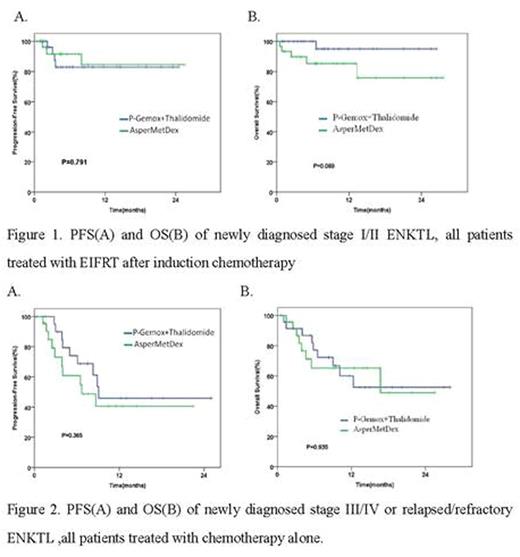Abstract
Backgroud and Purpose
Extranodal natural killer/T-cell lymphoma (ENKTL) is an uncommon, aggressive form of non-Hodgkin's lymphoma. Optimal therapeutic strategies have not been fully defined yet. Both AsperMetDex and P-Gemox is recommended as major effective regimen by 2016 NCCN guideline. Therefore, we try to evaluate the efficacy and toxicity for P-Gemox plus thalidomide and AsperMetDex followed by EIFRT as first-line treatment for newly diagnosed stage I/II patients and as salvage regimen for newly diagnosed stage III/IV or relapsed/refractory ENKTL in this study.
Patients and methods
We initiated a prospective, multicentre, randomized, phase III ,non-inferiority clinical trial at 12 centers in China at March 2014. Patients were randomly assigned to receive either P-Gemox+thalidomide regimen (Group A: Pegaspargase 2000U/m2; im d1, Gemcitabine 1000mg/m2; ivdrip , d1, d8. Oxaliplatin 130mg/m2; ivdrip, d1, thalidomide 100mg/d po, for one year.) or AsperMetDex regimen(Group B: Pegaspargase 2000U/m2; im, d1, Methotrexate 3000mg/ m2; civ 6-hour, d1, calcium folinate 30mg iv, q6h, until reach safe serum MTX concentration, Dexamethasone 40mg/d ivdrip, d1-4.). For newly diagnosed stage I/II patients, both regimens were repeated every three weeks for a maximum four cycles as induction chemotherapy and followed by EIFRT at the dosage of 56Gy in 28 fractions over 4 weeks. Primary EIFRT was delivered using 6-MeV linear accelerator using 3-dimensional conformal treatment planning. For newly diagnosed stage III/IV or relapsed/refractory ENKTL, the regimens were repeated every three weeks for a maximum six cycles. Patients underwent autologous hematopoietic stem cell transplantation (ASCT) as consolidation if they achieved response (complete remission, CR or partial remission, PR). The primary endpoint was progression-free survival(PFS), with a non-inferiority margin of 15%.
Results
110 patients were enrolled (56 patients in Group A, 54 in Group B) and 96 patients were evaluable for response. Among 63 newly diagnosed stage I/II patients, 32 patients were assigned to Group A (27 assessed), and 31 to Group B (27 assessed). At median follow-up of 13.5 months (IQR 0.5¨C27.5), 2-year PFS were 82.9%(95%CI:17.574-24.111) and 84.5% (95%CI:18.849- 25.688). 2-year OS were 95.0%(95%CI:13.023-22.896) and 75.8%(95%CI:11.647-21.269), P=0.089, (Figure1). CR rate of both group were all 59.3%(16/27), and objective response rate(ORR) were 85.2%(23/27) and 81.5%(16/27), respectively. After EIFRT, ORR of Group A increased to 92.6% (25/27), CR rate was 88.8% (24/27). ORR of Group B increased to 88.8% (24/27), CR rate was 85.1% (23/27). For 47 newly diagnosed stage III/IV or relapsed/refractory patients, 24 patients were assigned to Group A (22 assessed) and 23 to Group B (20 assessed). At median follow-up of 14.5 months (IQR 0.6¨C28.1), median PFS was longer in the Group A than Group B(12.2 vs. 7.6 months, P=0.365). 2-year OS were 52.5%(95%CI:13.023-22.896) and 48.9% (95%CI:11.647- 21.269), P=0.935 (Figure2). The ORR were 86.4%(19/22) and 70%(14/20), respectively. CR rate were similar for both group with 50%. Six cases (3 cases in each group ) had received ASCT after response, 3 patients relapsed in 6 months after ASCT(2 cases in group A, 1 case in group B) , 2 patients died of disease progression. Group B was better tolerated than Group A, with lower rates of agranulocytosis, thrombocytopenia and infections. While anemia, hyperbilirubinemia, edema, and increased BUN/Cr were more common in Group B. Three patients died of treatment related toxicity only in Group B. Two patients died of severe acute renal failure and sepsis at the first cycle, and one patient died of sepsis at the third cycle (Table 1). Median hospitalization time were 1.9 days for Group A and 4.9 days for Group B(P<0.01), respectively.
CONCLUSION: Induction chemotherapy of both P-Gemox+Thalidomide and AsperMetDex regimen followed by ENKTL yielded promising efficacy for patients with stage I/II ENKTL. For advanced or relapsed patients, both regimen showed unsatisfied survival outcome. Meanwhile, P-Gemox+ Thalidomide may be less toxic with more simple and convenient administration in outpatients clinics in comparison to AsperMetDex. This clinical trial is still ongoing . (ClinicalTrials.gov, NCT 2085655).
Funding: 5010 Program for Clinical Research , Sun Yat -Sen University.
No relevant conflicts of interest to declare.
Author notes
Asterisk with author names denotes non-ASH members.



